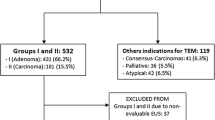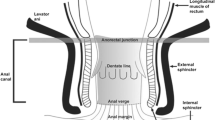Abstract.
In a prospective study we examined the value of endorectal ultrasound (ERUS) in the preoperative staging of potentially locally excisable tumours. During the study period from 1.1.1991 to 1.3.1996 a total of 160 rectal tumours in 152 patients were staged endosonographically (uT/uN) and compared postoperatively with the histologic result (pT/pN) at the University Hospital of Würzburg. Thirty-eight (24%) patients had an adenoma and 15 (9%) a T1-carcinoma. In 29 (18%) cases a T2-cancer was diagnosed, further 67 (42%) and 11 (7%) patients presented with a T3 and T4 tumour, respectively. The sensitivity for adenomas and T1-Ca (uT0/1) was 81%, the specificity 98%. For T2 tumours the sensitivity was only 41% and the specificity 92% as the majority (17 of 29) of pT2 neoplasias were overstaged (uT3). The overall staging accuracy (T1 – 4) was 77.5%. Two patients with a pT1-Ca and seven with a pT2-Ca had lymph node metastases which were detected preoperatively in five. The accuracy for lymph node staging was 83%. We conclude that adenomas and T1 tumours can be assessed with a high grade of accuracy using ERUS. In these tumours ERUS can be used to assist clinical decision-making (transanal vs. abdominal operation). Owing to the lack of sensitivity, ERUS is of no help in the assessment of T2 carcinomas.
Résumé.
Au cours d'une étude prospective, nous avons examiné la valeur de l'échographie endorectale (ERUS) dans la détermination pré-opératoire du stade des tumeurs susceptibles d'être excisées localement. Au cours d'une période allant du 1er janvier 1991 au 1er mars 1995, sur un total de 160 tumeurs rectales, 152 ont fait l'objet d'une détermination endosonographique de leur stade (uT/uN) et ont été comparées avec les résultats postopératoires de l'histologie (pT/pN) à l'Hôpital universitaire de Wurzburg. Trente-huit patients (24%) étaient porteurs d'un adénome et 15 (9%) d'un cancer au stade T1. Chez 29 patients (18%) le diagnostic retenu est d'un cancer au stade T2; de plus, 67 (42%) et 11 patients (7%) patients étaient respectivement porteurs d'une tumeur au stade T 3 et T 4. La sensibilité pour les adénomes et les cancers au stade T1 (uT0/1) était de 81% avec une spécificité de 98%. Pour les tumeurs au stade T2, la sensibilité n'était que de 41% et la spécificité de 92% étant donné que la majorité des cancers au stade pT2 (17/29) ont été surestimés (uT3). L'exactitude du stade globalement était (T1 – 4) de 77,5%. Deux patients avec un cancer pT1 et 7 avec un cancer pT2 présentaient des métastases ganglionnaires qui avaient été diagnostiquées en pré-opératoire chez 5 d'entre eux. L'exactitude dans la mise en évidence de ganglions lymphatiques est de 83%. Nous concluons que les adénomes et les tumeurs au stade T1 peuvent être diagnostiqués avec une très grande exactitude au moyen de l'échographie endo-rectale. Dans ces tumeurs, l'échographie peut être utilisée comme aide au diagnostic et au choix thérapeutique (opération par voie transanale versus opératoire par voie abdominale). En raison du manque des sensibilité , l'échographie n'ait d'aucune aide dans la détermination des cancers au stade T2.
Similar content being viewed by others
Author information
Authors and Affiliations
Additional information
Accepted: 22 March 1997
Rights and permissions
About this article
Cite this article
Sailer, M., Leppert, R., Kraemer, M. et al. The value of endorectal ultrasound in the assessment of adenomas, T1- and T2-carcinomas. Int J Colorect Dis 12, 214–219 (1997). https://doi.org/10.1007/s003840050092
Issue Date:
DOI: https://doi.org/10.1007/s003840050092




